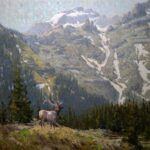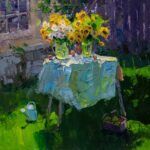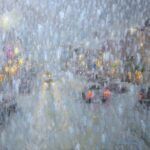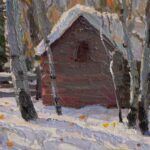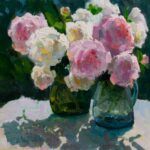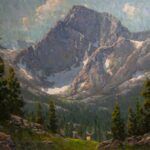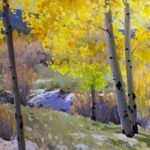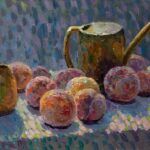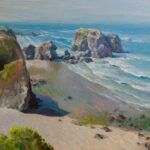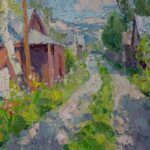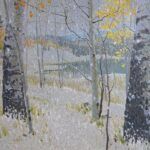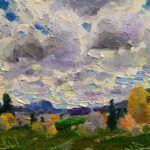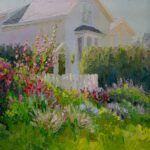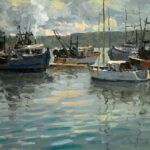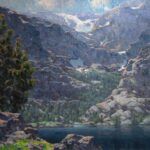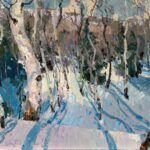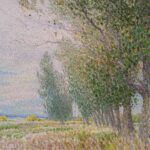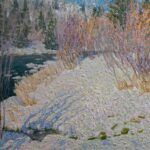Gregory Packard explores his surroundings in layers of light and color
By Elizabeth L. Delaney
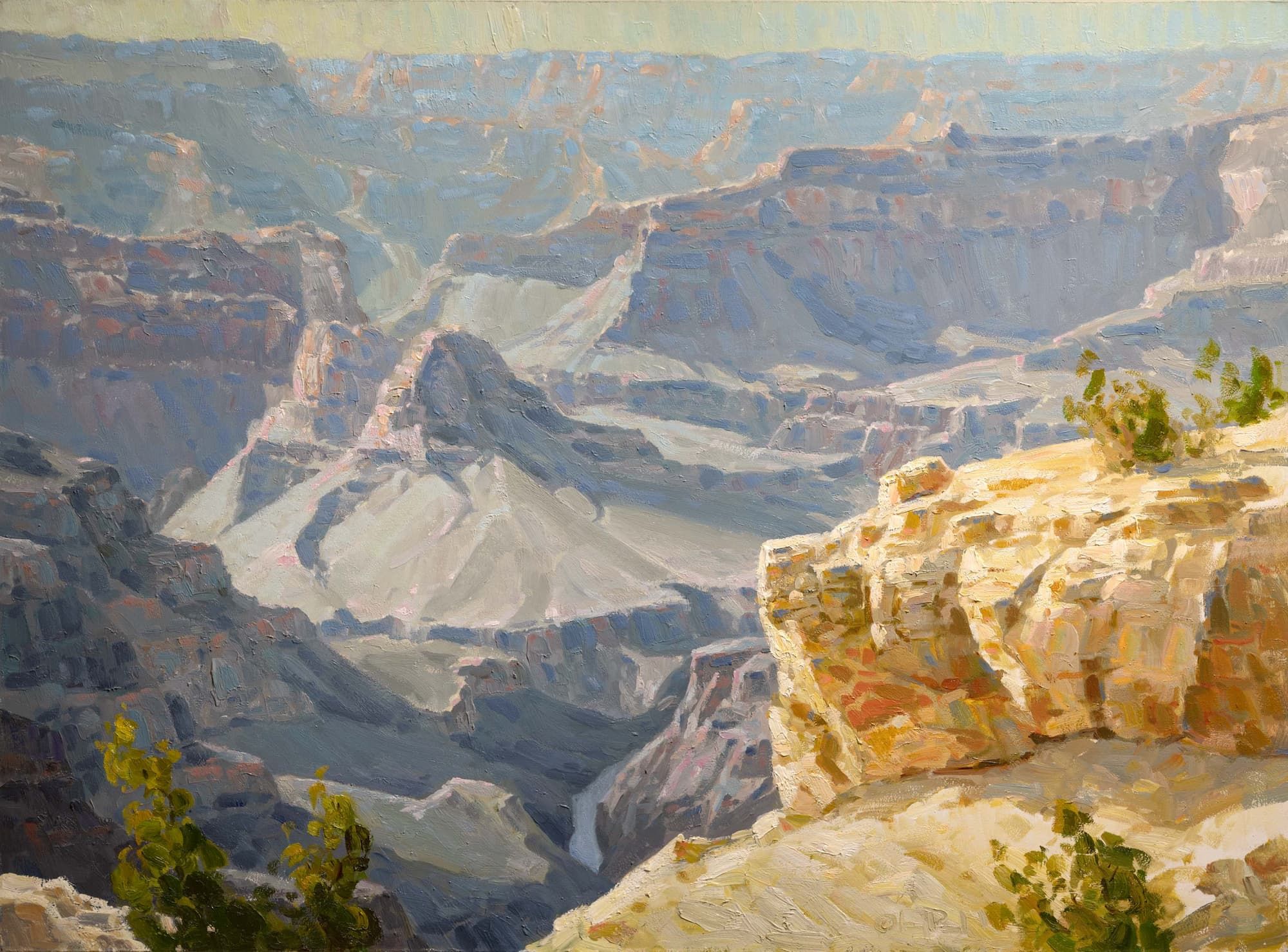
Gregory Packard, Canyon Atmosphere, oil, 36 x 48.
Gregory Packard’s decision to become a professional painter came as a surprise to him. However, a bird’s-eye view of his life reveals that, from the very beginning, he exhibited the traits that would become the foundation of his fine-art career—a love of drawing and a kinship with the natural world.
Packard grew up in central Idaho, not far from the unspoiled rural settings of towns like Stanley and Yellow Pine. Mountains, forests, and river landscapes all called to him, and he relished spending time camping, exploring, and communing with the textures, innumerable colors, and pure light found out in the elements.
- Gregory Packard, Westfork Elk, oil, 48 x 50.
- Gregory Packard, Outdoor Floral, oil, 16 x 16.
- Gregory Packard, Ouray, oil, 24 x 30.
Packard’s love of nature was matched perhaps only by his affinity for drawing. An introverted and introspective child, he spent a lot of time with pencil in hand, making tight, photorealistic depictions of the world around him. Not only did Packard love to draw, but drawing seemed to love him. Amid the many challenges of transitioning from child to adolescent to adult, drawing always felt like something he was good at. But it would be quite some time before Packard looked at art-making as the thing that might sustain him professionally, not just spiritually.
Packard studied English in college, and although it was relegated to the periphery, he continued to make art. He and his friend rented a small studio, where he carried on with the meticulous, realistic drawings that had sustained him to that point. He also began to broaden his artistic horizons, taking several painting classes as electives. These classes were the first time he had tried his hand at painting, and, perhaps not surprisingly, he found that he had an affinity for that as well.
Art still remained in the background, however, and after Packard earned his degree, he began working as a technical writer. Then, when he was 28, everything changed.
- Gregory Packard, Little Red Cabin, oil, 8 x 16.
- Gregory Packard, Peonies in Sunshine, oil, 20 x 24.
- Gregory Packard, High Country Hierarchy, oil, 48 x 60.
He was in downtown Boise on business one day when he wandered into a gallery and saw the work of noted impressionistic landscape painter Robert Moore. After talking to the gallery owner, he learned that Moore would be teaching a workshop, and Packard—inspired by Moore’s painting style—decided to sign up. He then visited another nearby gallery and learned that painter Del Gish would also be teaching a workshop. He enrolled in that one as well. During his stint studying with Moore, Packard was exploring the older artist’s library when he came across books featuring Russian Impressionist painters. He had seen Monets in museums and California Impressionists in magazines, but this experience lit a fuse within him. “I knew then I had to pursue it,” he says of the decision to become a full-time artist. “The Russian Impressionists stirred something in me that was childlike and primitive. I couldn’t not choose it.”
Packard pursued painting with zeal and determination. He observed and learned from other artists like Monet, Manet, van Gogh, Wyeth, and his teachers Moore and Gish. He took additional workshops and taught himself how to paint in the style that spoke to him. He became obsessed with learning the craft of painting. “I didn’t really have a choice at that point,” he says.
- Gregory Packard, Autumn Glow, oil, 36 x 36.
- Gregory Packard, Peaches, oil, 12 x 24.
- Gregory Packard, The Beautiful Pacific, oil, 30 x 48.
That was more than two decades ago, and today Packard has flourished as a fine artist, carrying on the legacy of impressionistic painters near and far, bringing rural and urban vignettes to life from his own creative viewpoint. He has lived in Montrose, CO, not far from Grand Junction, for the past 17 years. He finds the local scenery and climate inspiring, and, in the recent past, he has done most of his painting in the vicinity of his home. “I try to find subjects that I really love,” he says. And that love comes through to viewers.
Packard populates his canvases with landscapes, cityscapes, and still lifes that radiate light and color. He has recently embraced his interest in snow scenes more ardently, in particular his fascination with a city block blanketed in white or a mountain lake surrounded by aspen trees in a storm. As a painter driven by conveying the mood of a scene, Packard is especially drawn to the quiet power of a snowstorm and the forces of nature that are both intimidating and beautiful.
Packard typically works from photographs that he takes while exploring. He carries his camera with him so he can capture potential subjects while walking through the Colorado wilderness or going for a drive. When it comes time to paint, aside from knowing the subject matter he wants to interpret, he doesn’t have a plan for how he’ll arrive at the finished piece. It evolves as he’s working, like he’s opening a gift or reading a book. “It just unfolds,” he says. “I struggle with each painting, and the struggle is part of the beauty of it. It comes out through that struggle.”
- Gregory Packard, Crested Butte Charm, oil, 14 x 20.
- Gregory Packard, Intuition, oil, 5 x 6 feet.
- Gregory Packard, Colorado Show, oil, 8 x 15.
Of his creative process, Packard remarks, “You have to start by making a beautiful mess.” Over the years, he has learned to work through the chaos and uncertainty of each painting, trusting that eventually he’ll come out on the other side. Although it is organic and amorphous, this way of painting takes its own type of discipline, and Packard is comfortable navigating uncharted waters until he sees that glimmer that tells him the composition is working, visually as well as emotionally.
In each of his paintings, Packard aims to harness the power of color, texture, and light to make his subject come alive in two dimensions, to draw the viewer in and hold their attention. “The heart of a painting, for me, is the light,” he explains. Whether bright sun or dismal fog, he explores how light affects every composition. He translates the way light expands and contracts, illuminates and shades, and creates the intangible feeling of atmosphere.
Packard employs texture to activate energy and movement, and his paintings possess a formidable tactility and dimension. As much as they create their own environment on the canvas, the thick, plush layers of paint also seem to subtly reach into the viewer’s space.
- Gregory Packard, By Design, oil, 20 x 24.
- Gregory Packard, Little Working Boats, oil, 16 x 20.
- Gregory Packard, Lake in the Winds, oil, 48 x 50.
The artist likes to experiment, both with tools and application techniques. He may use brushes for one painting and a palette knife for the next. When trying to produce a quick burst of energy, he paints wet-on-wet, or alla prima, quickly applying pigments for a fresh, in-the-moment feel.
Another technique he employs is a broken color application, in which he layers small strokes of paint in different colors onto the canvas, as opposed to mixing them on his palette first; they fuse together to create new hues while simultaneously preserving the originals. In this manner, the dynamic color pairings produce a low-frequency visual energy. Packard calls these his “slow burn” paintings, and indeed, they evoke a sizzling undercurrent. “I work really hard to get rich color and good color and harmonizing color,” Packard says.
It’s this broken color technique, heralded by historic and contemporary impressionists alike, that Packard intends to hone further as he moves forward in his career. The artist is currently in a period of transition after spending the past two decades building his career while focusing on family and raising two children. Now, Packard and his wife are on their way to becoming empty nesters—something the artist anticipates will change the way he works.
- Gregory Packard, Long Shadows, oil, 30 x 40.
- Gregory Packard, Meet Me Under the Large Cottonwood, oil, 40 x 48.
- Gregory Packard, Subtle Winter Whisper, oil, 36 x 48.
He looks forward to traveling and experiencing new surroundings and potential subject matter. He wants to return to the spaces frequented by his artistic heroes in France, Italy, and Portugal, to absorb the intricacies of light and color within those landscapes firsthand. “It’s good to reinvigorate your passion and find things new and exciting,” he says.
Ultimately, Packard wants to continue painting the things he loves, fusing his passion for art-making with his adoration of the natural world and sharing his gratitude and inspiration with viewers. “One of the main drives behind my paintings is to bring a point of joy,” he says. “It’s what gives my work value.”
It’s also important to Packard that his work inspires some emotion or provokes contemplation in viewers. “It’s my way of contributing,” he says simply. “I think it matters.”
representation
Astoria Fine Art, Jackson, WY; Broadmoor Galleries, Colorado Springs, CO; Cimarron Song Gallery, Montrose, CO; The Brinton Museum, Big Horn, WY; Oh Be Joyful Gallery, Crested Butte, CO; www.gregorypackard.com.
This story appeared in the October/November 2022 issue of Southwest Art magazine.






